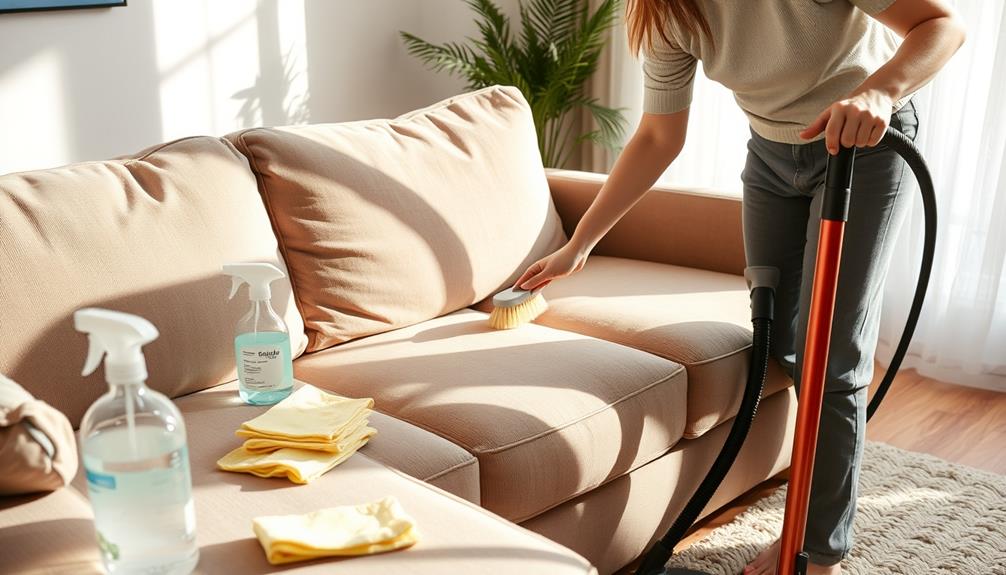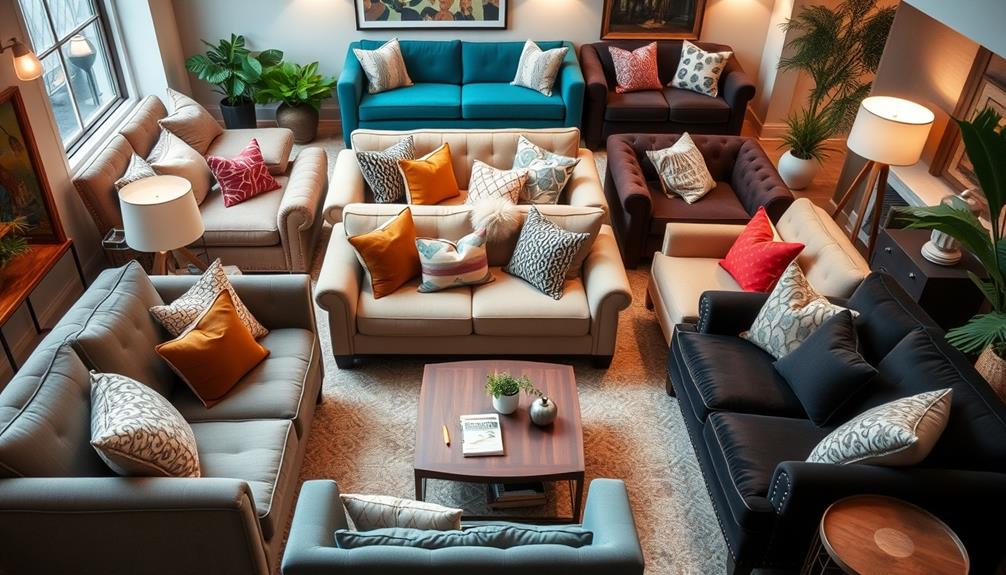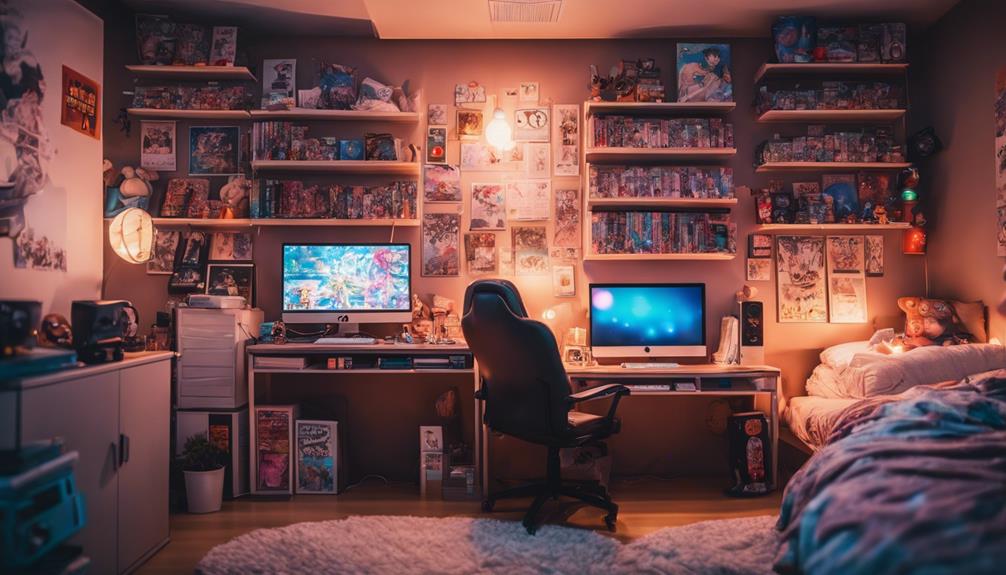Cleaning your sofa is essential for keeping it fresh and free of allergens. To start, utilize an upholstery attachment when vacuuming to eliminate hair and dust. If spills occur, address them promptly by blotting them up and using a cleaning solution suited for your sofa’s fabric. For stubborn stains, you can try a DIY mixture of vinegar, water, and dish soap. Make sure to rinse thoroughly to prevent any residue from forming. It is recommended to schedule a deep clean every 12-18 months, and if you encounter persistent issues, consider seeking professional assistance. By following these steps, you will preserve the beauty and lifespan of your sofa. There is much more to learn about specific cleaning techniques for different types of fabrics.
Key Takeaways
- Regularly vacuum your sofa every 3-4 weeks to remove dust, allergens, and pet hair for better indoor air quality.
- Immediately blot spills with a clean cloth to prevent stains from setting, using appropriate cleaning solutions based on fabric type.
- Deep clean your sofa at least once a year to maintain its appearance and longevity, using methods suitable for its specific fabric.
- For persistent stains, utilize DIY cleaners like vinegar and dish soap, ensuring to rinse thoroughly to avoid residue.
- Consider professional cleaning services for a thorough deep clean and improved indoor air quality, especially if your home has pets.
Importance of Regular Cleaning
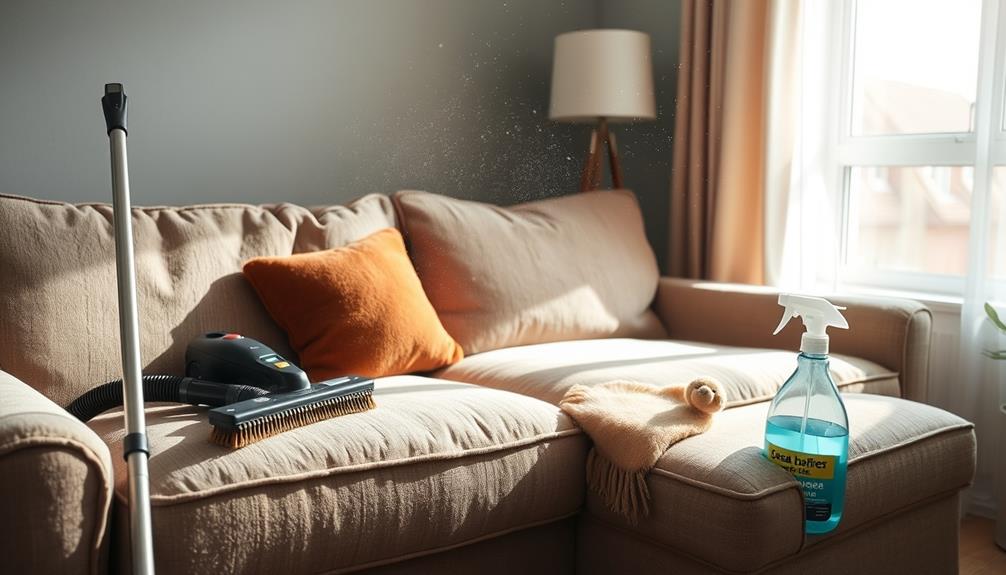
Regular cleaning of your sofa is essential for maintaining a healthy home. By keeping up with regular cleaning, you can prevent the buildup of dust, allergens, and germs that negatively impact your indoor air quality. This is especially important if you have pets or allergy sufferers in your household.
Additionally, maintaining clean air through practices such as using an air purifier can complement your sofa cleaning efforts, ensuring that your living environment is as healthy as possible air purifier maintenance dos and don'ts. Deep cleaning your upholstery once or twice a year, combined with surface cleaning every 3-4 weeks, greatly enhances both the longevity and appearance of your couch.
Neglecting to clean your sofa can lead to accumulated dirt and stains, making it harder to maintain in the long run. Regular maintenance like vacuuming and spot cleaning not only keeps your couch looking fresh but also helps avoid major health issues.
A clean sofa makes your living space more comfortable and inviting, while also preserving the integrity of the fabric. Ultimately, establishing a cleaning routine can save you time and effort down the line.
Immediate Cleaning Situations
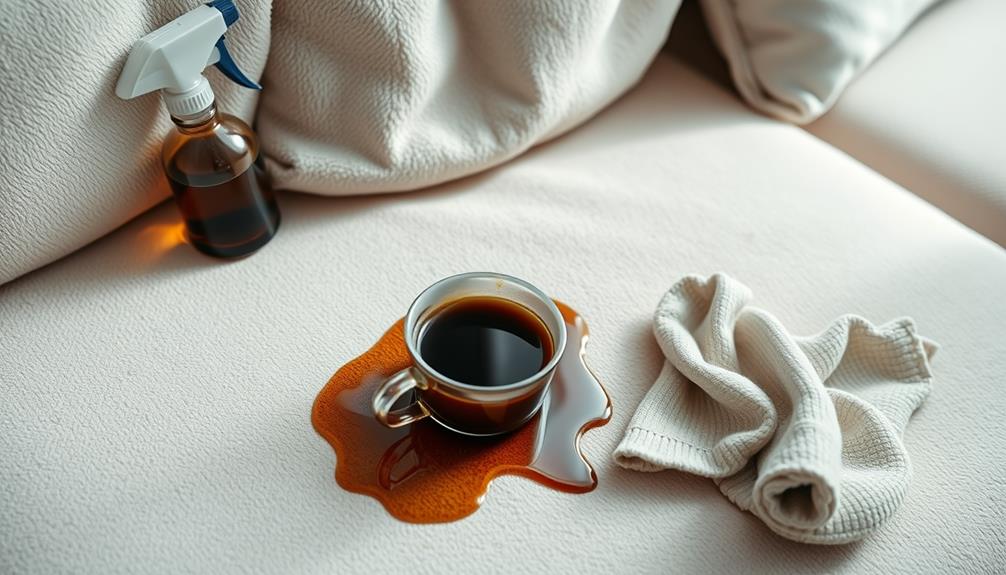
When it comes to your sofa, quick action during spills or accidents is essential for preventing stains and odors. Immediate cleaning not only helps maintain your sofa's appearance but also extends its lifespan.
In addition to acting fast, it's important to take into account the type of fabric your sofa is made from, as different materials may require specific cleaning methods. For instance, using appropriate cleaning solutions can prevent damage and guarantee effective stain removal, which can be found in cold medications overview.
Here are some key situations where you should act fast:
- Food and Beverage Spills: If you spill liquid, it can seep into the fabric. Blot the area immediately with a clean cloth and use an upholstery cleaner designed for your sofa's material.
- Pet Stains: For those unfortunate pet accidents, use an enzymatic cleaner right away. This helps neutralize odors and prevents your pet from returning to the same spot.
- Road Salt Residue: In winter, road salt can damage your upholstery. Wipe it off promptly to maintain your sofa's look and feel.
Step-by-Step Cleaning Process

Begin your sofa cleaning journey by removing any hair and debris with an upholstery vacuum attachment. This step guarantees a thorough clean before applying any cleaning solutions.
For a deeper clean, consider steam cleaning your upholstered furniture to eliminate odors and allergens, similar to the benefits of professional cleaning over DIY methods in mechanic shops for fuel injection cleaning. Make sure to allow the cushions to dry completely to prevent moisture retention.
Next, if you plan to use a fabric-safe disinfectant spray or a homemade cleaning solution, always test it on a hidden area of the sofa first. This helps avoid potential damage to your upholstery.
For stubborn stains, act quickly: blot the area immediately, then apply a detergent solution with a clean sponge. Rinse with water to remove any residue afterward.
To maintain your sofa, vacuum it every 3-4 weeks and schedule a deep clean every 12-18 months. This regular maintenance not only keeps your sofa looking fresh but also prolongs its life.
Techniques for Different Fabrics

Different fabrics require unique cleaning techniques to maintain their appearance and longevity. Here's how to tackle various fabric upholstery:
Additionally, understanding the mechanics of fabric care can enhance the overall cleaning experience, much like various brewing methods affect coffee quality.
- Cloth Couch: Mix baking soda with a DIY cleaning solution of dish soap, vinegar, and water. Gently dab stains and let it dry for effective cleaning.
- Microfiber Couch: Spray rubbing alcohol on stained areas and scrub gently with a soft cloth. Once done, fluff the fabric with a dry brush for a refreshed look.
- Suede Couch: Use a soft brush to lift dirt. Apply a suede cleaner without water, blot any stains, and allow the fabric to dry naturally to preserve its texture.
For velvet couches, quickly absorb moisture with paper towels, lift solid stains with a butter knife, and steam clean to eliminate wrinkles while using a soft brush to maintain the fabric.
When dealing with couch cushions, vacuum thoroughly and use a solvent-based cleaning solution suited for the fabric type. Always perform a spot test in an inconspicuous area first to avoid any damage.
Evaluating Your Couch's Condition

How can you determine if your couch needs cleaning or replacement? Start by evaluating the overall appearance of your couch. Look for signs of thinning, staining, or tearing, as these can indicate that it's time to clean your couch or even consider a replacement.
Regular maintenance can extend the lifespan of your furniture, just as it does for appliances like energy-efficient appliances that help lower overall energy consumption.
Next, locate the fabric care tag; this will give you essential information about the Type of Fabric and the appropriate cleaning methods.
Evaluate the couch's comfort and structural integrity by testing the couch cushions. Make sure they feel firm and supportive.
Also, check that the frame is stable, without any creaking or wobbling. Persistent odors or allergens can signal a need for deep cleaning, especially if you have pets or allergy sufferers in your home.
Benefits of Professional Cleaning
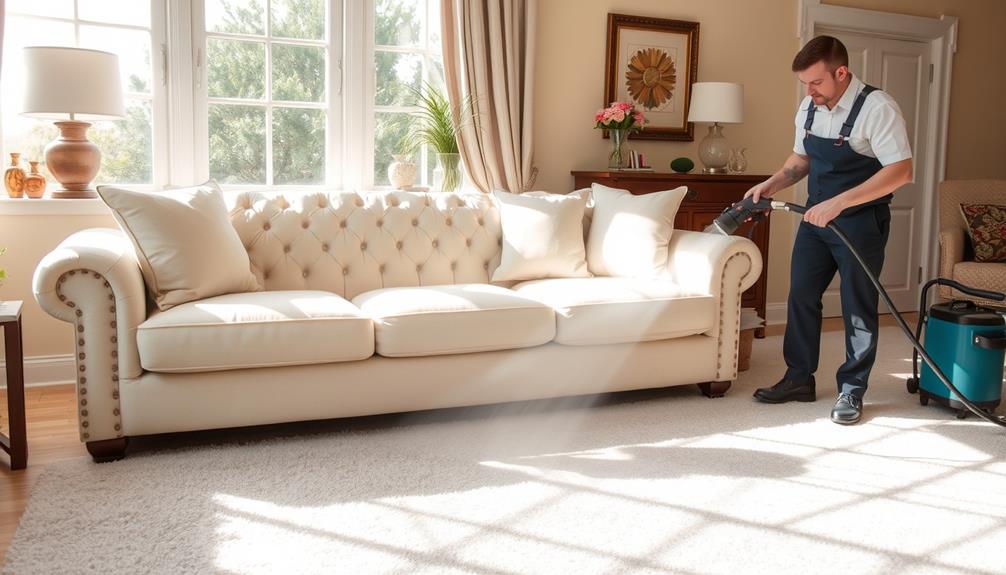
When it comes to maintaining your sofa, professional cleaning offers a host of benefits that go beyond mere aesthetics. Engaging in upholstery cleaning not only enhances the look of your furniture but also contributes to a healthier home environment.
Regular cleaning can help protect seniors from financial scams by guaranteeing a safe and clean living space, especially for those who may be more susceptible to allergens and bacteria.
Here are three key benefits of opting for professional cleaning:
- Improved Indoor Air Quality: Professional cleaning effectively removes dust, allergens, and pollutants, greatly enhancing indoor air quality. This is especially essential for homes with pets or allergy sufferers.
- Extended Lifespan of Furniture: With specialized equipment and expertise, professional cleaners tackle tough stains and maintain the integrity of your upholstery. This guarantees your sofa lasts longer, saving you money in the long run.
- Comprehensive Hygiene: Regular professional cleaning eliminates harmful bacteria, allergens, and mold, promoting overall cleanliness and hygiene in your home.
Plus, with services backed by guarantees, you can have peace of mind knowing the job is done thoroughly and efficiently.
Addressing Stains Effectively
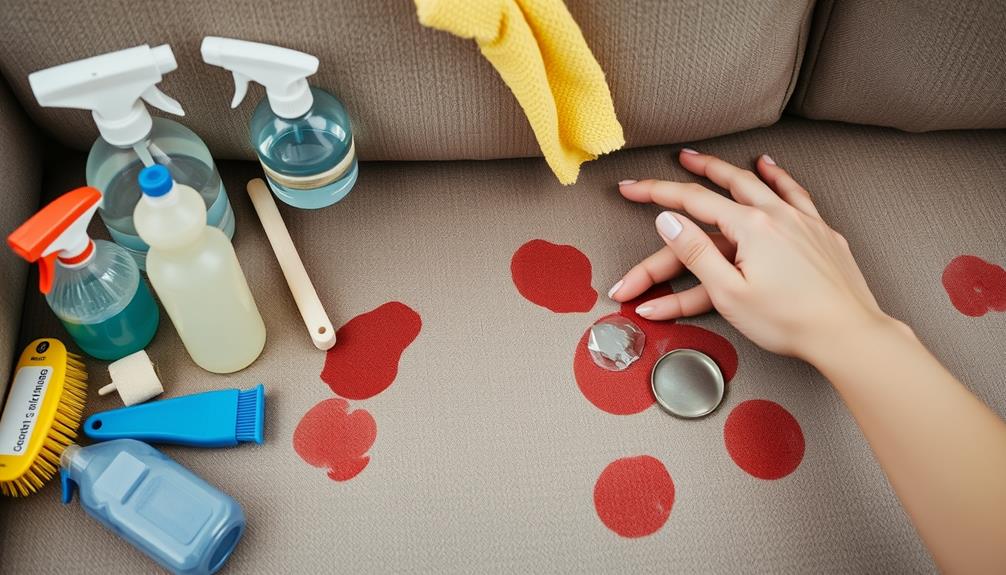
Stains are inevitable, but addressing them quickly can prevent lasting damage to your sofa. As soon as a spill occurs, blot it immediately with absorbent cloths. Avoid rubbing the area, as this can spread the stain further.
For fabric upholstery, you can create a DIY cleaner using a mixture of vinegar, water, and dish soap. Apply this solution with a clean sponge, and remember to rinse afterward. To guarantee your cleaning efforts are effective, consider using a vacuum with strong suction power, such as those reviewed in the best vacuums for dust removal in 2024.
Different fabrics require specific cleaning methods. For instance, use rubbing alcohol on microfiber couches, while a soft brush with suede cleaner works best for suede materials. If you encounter tough stains, consider applying a detergent solution and letting it sit for a few minutes before rinsing. This can help lift the stain effectively.
Before using any cleaning solution, always test it on a hidden area of the fabric first. This step guarantees you won't accidentally cause discoloration or damage.
Choosing High-Quality Upholstery
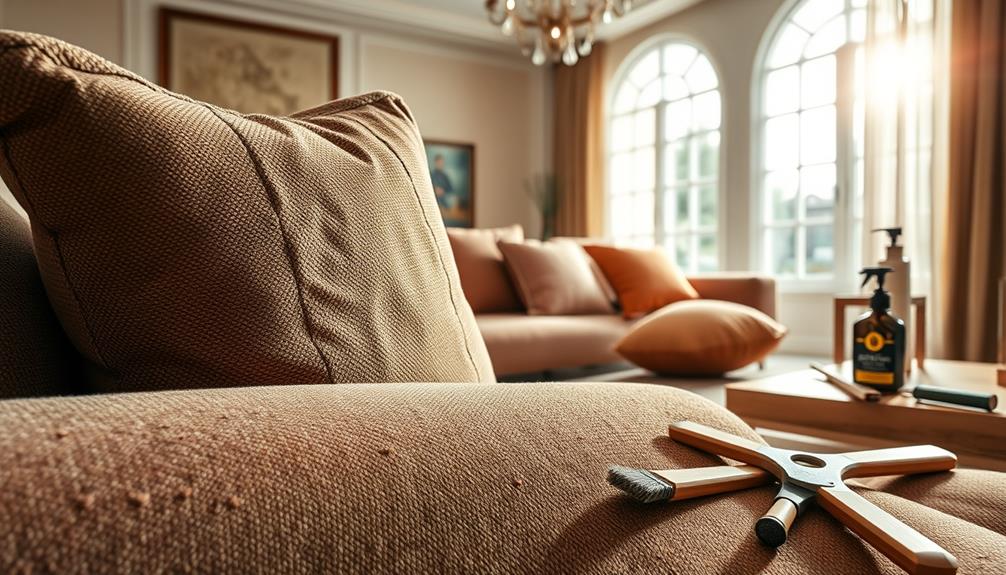
Selecting high-quality upholstery can markedly enhance the comfort and appearance of your sofa. To make the best choice, focus on these key factors:
- Durable Fabrics: Prioritize materials like washed linen and eco-friendly blends. These fabrics not only look great but also guarantee longevity and ease of maintenance, similar to the essential items in bug out bags that emphasize durability.
- Stain-Resistant Treatment: Look for upholstery treated with products like Scotchgard. This treatment creates a barrier against spills, helping to prevent stains from setting in.
- Fabric Codes: Always check the care tags for fabric codes. Codes like "W" indicate water-safe fabrics, while "S" means solvent cleaner only, guiding you on the appropriate cleaning methods.
Additionally, aim for upholstery with a high rub count (15,000 or more) for better wear resistance, especially in high-traffic areas.
Investing in upholstery that comes with a solid warranty offers peace of mind, guaranteeing coverage against defects and boosting the overall value of your purchase.
Frequently Asked Questions
What Is the Best Way to Clean a Fabric Sofa?
To clean a fabric sofa effectively, vacuum it first to remove dirt. Then, use a solution of vinegar and water, blot stains, and rinse with a damp cloth. Always check the care tag for specific instructions. If the sofa is still dirty, consider using a commercial upholstery cleaner and following the manufacturer’s instructions. For tough stains, it may be necessary to hire a professional cleaner. If the sofa is too old and beyond repair, consider old sofa disposal options, such as donating it to a charity, recycling it, or hiring a junk removal service to dispose of it responsibly. Additionally, regular maintenance can extend the life of your fabric sofa, so consider incorporating some sofa cleaning tips at home into your routine. This might include rotating cushions to ensure even wear and using fabric protectors to repel stains. By taking these proactive steps, you can keep your sofa looking fresh and inviting for years to come.
How Can I Deep Clean My Couch at Home?
Think of deep cleaning your couch as rejuvenating a tired canvas. Start by vacuuming, then scrub with a warm water solution. If possible, steam clean for an extra refresh. Don't forget to dry thoroughly!
How Do You Clean a Dirty Couch Without a Machine?
To clean a dirty couch without a machine, start by vacuuming thoroughly. Then, use a mixture of vinegar and water to scrub stains, blot spills immediately, and sprinkle baking soda to eliminate odors. Rotate cushions regularly.
How Do You Clean a Couch and Make It Smell Good?
Oh sure, just wave a magic wand and your couch will smell like roses! Seriously, vacuum it first, use a vinegar-water mix, sprinkle baking soda, and finish with a fabric-safe freshener for that delightful scent.
Conclusion
To summarize, cleaning your sofa isn't just about aesthetics; it's about maintaining a healthy home environment. Regular upkeep, immediate attention to spills, and knowing your fabric type can make all the difference. Have you considered how much time you spend on your couch and what it says about your living space? By investing in proper care and occasional professional cleaning, you can guarantee your sofa remains a cozy, inviting centerpiece for years to come.
